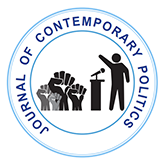


Journal of Contemporary Politics
Year: 2025, Volume: 4, Issue: 3, Pages: 94–100
Original Article
Allen David Simon1,∗, Rajashree Addy1, Shovontika Chakraborty1
1M.A. (Political Science) candidate, Postgraduate and Research Department of Political Science, St. Xavier’s College (Autonomous), University of Calcutta, Kolkata, West Bengal, India
∗Corresponding author.
Allen David Simon
Email: allendavidsimon2003@gmail.com
Received Date:25 March 2025, Accepted Date:08 July 2025, Published Date:24 October 2025
‘What is the underlying cause for the Manipur Conflict?’ The research article evaluates the ethnic composition of Manipur as a multicultural state with presumed dichotomies that have given a “conspicuous” nature to its society and polity, creating strife between the Meiteis and Kukis which has resulted in ethnic violence since 2023, and a failure of state machinery to resolve it swiftly. Located in a geopolitical hotspot, Manipur has suffered from relative neglect and a prolonged history of insurgency that has resulted in a backsliding of democracy and development, coupled with a heightening of communal violence as well as gruesome atrocities committed against women, who continue to bear the brunt of retaliation and vengeance. Since India's independence, Manipur's historical trajectory has been dotted with several instances of ethnic unrest. This paper tries to situate the recent 2023 uprising in existing theories of ethnic conflict while also noting the reactions of the political leadership and suggesting peacebuilding efforts.
Keywords: Manipur, Nature of government intervention, Response and reactions, Conspicuous identity, Securitization of identity, Weaponization, Dishonour, Dehumanization
© 2025 Published by Bangalore University. This is an open-access article under the CC BY license (https://creativecommons.org/licenses/by/4.0/)
Subscribe now for latest articles and news.